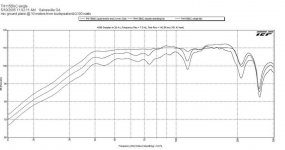on the outer cabs, the amount of delay is calculated from the outer distance the center stack?
umm... I'm not sure how to 'calculate' the amount of delay. Based on the edge to edge spacing of the mouths -- it's different. There is a maximum spacing edge to edge for subs to 'combine', and It is directly related to the upper frequency you want your subs to produce, however a good rule of thumb is about 4' or less. (the wider the spacing the more delay needed, however it will be somewhere between 1 and 4 milliseconds.)
What I did is use a spl meter and sine wave. Start the sinewave and measure straight on. Then move the spl meter to 45degree off axis. Start dialing in delay until the 45 degree off axis and straight on are about equal. As you add delay, at some point you'll start to hear a 'hollow' or weird kind of sound head on -- that's what tells you, you delayed too far.
umm... I'm not sure how to 'calculate' the amount of delay. Based on the edge to edge spacing of the mouths -- it's different. There is a maximum spacing edge to edge for subs to 'combine', and It is directly related to the upper frequency you want your subs to produce, however a good rule of thumb is about 4' or less. (the wider the spacing the more delay needed, however it will be somewhere between 1 and 4 milliseconds.)
What I did is use a spl meter and sine wave. Start the sinewave and measure straight on. Then move the spl meter to 45degree off axis. Start dialing in delay until the 45 degree off axis and straight on are about equal. As you add delay, at some point you'll start to hear a 'hollow' or weird kind of sound head on -- that's what tells you, you delayed too far.
Its about 1.1 milliseconds per foot.
Last edited:
Its about 1.1 milliseconds per foot.
yea... I got that.
TopShelf Can you fill in this word problem?
edge to edge spacing = 2' in a 4 box group.
45 degree off axis is -6db down with no delay.
how many ms delay to make 45 degree spl = 0 degree spl at 40hz?
(hint, I know the answer for MY BOX only.... because I measured it. anyone else's box, no idea...)
just knowing the speed of sound doesn't help me 'calculate' the outer box delay.
anyone got any formula's that might help?
Pythagorean theroum should Work. Depending on how far away the measurment is taken from test or listening point in front of the mmiddle or(reference) box.
ok, lets see if a2 + b2 =c2 comes up to the right answer.
30 feet measurement distance... measured in arc so its 30' head on, and 30' at 45degree off axis, measured from the center of the 4 box cluster. you have all of the numbers... lets see if you come up with what I know works.
btw, how does -6db relate to pythagorean theorum?
(bonus points for showing your work)
Interesting discussion regarding widening horizontal coverage when adding delay to outer pair of a stack of four speakers horizontally.
I wonder if the stereo image could be widened even further if stacking the speakers in an inverted arc in accordance to picture #21 in Rogs paper, combined with delaying the outer pair of speakers?
http://www.voidaudio.pl/attachments/article/147/A Practical Guide To Bass Arrays (angielski).pdf
The difference at 100 hz is 3.5 dB more horizontal spl with the inverted arc compared to a straight stack without delay.
Sorry for necromancy.. ��
I wonder if the stereo image could be widened even further if stacking the speakers in an inverted arc in accordance to picture #21 in Rogs paper, combined with delaying the outer pair of speakers?
http://www.voidaudio.pl/attachments/article/147/A Practical Guide To Bass Arrays (angielski).pdf
The difference at 100 hz is 3.5 dB more horizontal spl with the inverted arc compared to a straight stack without delay.
Sorry for necromancy.. ��
Last edited:
- Status
- This old topic is closed. If you want to reopen this topic, contact a moderator using the "Report Post" button.
- Home
- Loudspeakers
- Subwoofers
- Help needed choosing a design for live sound
